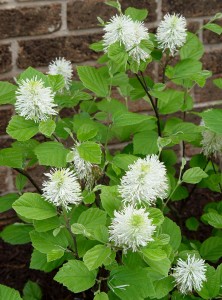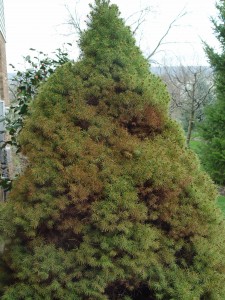Perfect Plants or Else
December 27th, 2011
Gardeners are a demanding sort these days.
Ask people what kind of plant they’re looking for, and most say they want plants that look great in all four seasons and that don’t get bug or disease problems.
We want plants that are colorful, that are different from what’s growing in every McDonald’s parking lot and that don’t take a lot of trimming, watering or other fussing.
We want plants that are cold-hardy in winter, heat-tough in summer and not likely to get eaten by deer, rabbits, groundhogs or voles in any season.
Something native and butterfly-attracting would be nice, too.
Above all else, we want plants that simply aren’t going to die in the lousy clay or shale soil most of us have.
And, oh yeah, we don’t want to pay a lot of money either.
That’s a pretty tall order. The surprising news is that these kinds of plants DO exist… except maybe for that last part.
I’m constantly impressed with the high performance of so many of the new plants hitting the market every year. Not everything new is better, but a lot of it is. (I’ll be writing about what’s new for 2012 in my four January garden columns in The Patriot-News and naming some of my favorite hard-working, low-care plants in next week’s post here.)
The bottom line is that we’ve got way more and way better choices today than even 10 years ago.
The dilemma is that you won’t find most of this stuff in the box stores, where so many “yardeners” buy their plants.
The Home Depots, Lowe’s and Walmarts of the world are focused primarily on price.
Their plant strategy is to skim off the mainstream selections, pick one or two of the best-known or easiest-to-grow varieties, and then mass out huge orders.
That gives people the low prices they want, but it also means they end up with the same ‘Blue Rug’ junipers, ‘Crimson Pygmy’ barberries, variegated euonymus and dwarf Alberta spruces year after year after year.
I like cheap prices as well as the next guy, but there’s a difference between bargains and value.
Getting a good product at a low price is a bargain. Getting a crappy product at a low price is bad value.
The problem I see is that so many of these mass-produced, commodity plants are prone to all sorts of drawbacks in the garden.
Those ‘Blue Rug’ junipers often get blight diseases or get eaten by voles. Variegated euonymus is prone to scale insects. Dwarf Alberta spruces are spider-mite magnets. Barberries are unkillable but have thorns that most people don’t like and often seed into the wild.
In short, most of the box-store fare has down sides that breeders have overcome in the superior new varieties that are available mainly at independent, locally owned garden centers (Ashcombe, Highland Gardens, Stauffers, etc.)
You’ll pay a few dollars more for these superior plants, but most of the time, I think it’s well worth it in survivability and long-term performance.
The sad part is that people tend to blame themselves when they end up with a landscape full of dead, struggling and bug-infested plants.
Most of the time, it’s not their ineptitude at all. It’s the combination of inferior plants and lousy soil.
I had an interesting talk about this a few weeks ago with David Wilson, a superb Lower Paxton Twp. gardener who’s also the marketing director for Garden Splendor Plants.
David tells me he’s seen a rather marked shift this year in gardeners going back to independent garden centers for their plant purchases.
That jives with the results from recent consumer polling by the Garden Writers Association, which found that plant sales are now neck-and-neck again between mass merchants and the independents. For several years, the majority had gone to the mass merchants.
“People have this fear of failure,” says David. “They have in the back of their mind, ‘If I buy this plant, will it die?’”
He says the foray into the no-help/iffy-performance world of box stores is convincing gardeners that their odds of success are better when dealing with small businesses that are passionate about plants.
The clearest sign he’s seen is that Garden Splendor plant orders for 2012 are up significantly. Maybe that’s also a sign that the economy is rebounding, but I think there’s more to it than that.
“People are voting with their wallets and not necessarily buying the cheapest but buying the best,” says David.
When it comes to plants, that’s a long-overdue trend.
(Curious about what other trends are taking shape in gardening for 2012? That’s the topic of my column this Thursday — Dec. 29 — in The Patriot-News.)









